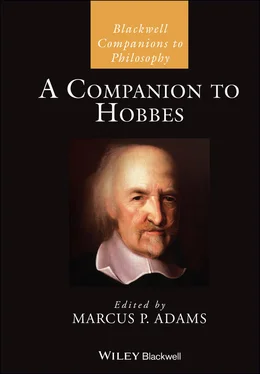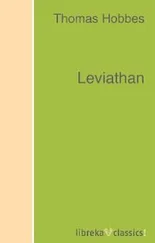(1635, 115)
This procedure leads to the theorem now known as “Cavalieri’s Principle”: if two figures have equal altitudes and sections made by lines parallel to the bases at equal distances are always in a given ratio, then the areas of the figures stand in the same ratio.
At first sight it may seem that Cavalieri takes continuous magnitudes (figures) to be composed of infinite collections of indivisibles (lines). He steadfastly denied this, however, and insisted that his method did not run afoul of traditional strictures against the use of infinitely small magnitudes. Other mathematicians who followed Cavalieri were not so cautious. Most notable for our purposes is Wallis’s pronouncement that “I suppose, to begin with (according to the Geometry of Indivisibles of Bonaventura Cavalieri) any plane to be made up (so to speak) out of an infinity of parallel lines; or (which I prefer) from an infinity of parallelograms of the same altitude. Let the altitude of any one of them be 1/∞ of the whole … and the altitude of all together being equal to the altitude of the figure” (1693–1699, 1:297). Wallis was hardly alone in this interpretation of Cavalieri: Evangelista Torricelli and Gilles Personne de Roberval were similarly inclined to take the method of indivisibles as based on the notion that continuous magnitudes are composed of infinite collections of infinitesimal parts. 11
For his part, Hobbes approved of Cavalieri’s method while dismissing Wallis’s approach as incoherent. In particular, he interpreted Cavalier’s notion of “all the lines” in a figure as consistent with his own principle that lines are not breadthless, but rather have a (negligible) breadth that is disregarded in a demonstration. On this interpretation, surfaces are literally composed of finite collections of lines, and Cavalieri’s method is fully consistent with the Hobbesian approach to geometry. It is in this sense that Hobbes could insist in Examinatio Dialogue 2 that:
Those things which can exceed one another when multiplied are homogeneous, and these are measurable by a measure of the same kind, as lengths are measurable by lengths, surfaces by surfaces, and solids by solids. However, things heterogeneous are measured by different kinds of measures. Nevertheless, if lines are considered as the most minute parallelograms, as they are considered by those who use the method of demonstration Bonaventura Cavalieri uses in the doctrine of indivisibles, then there will be a ratio between a right line and a plane surface. And indeed such lines, when multiplied, can exceed any given finite plane surface.
(OL IV.75)
Hobbes insisted that Wallis had failed to understand Cavalieri’s method, and by taking it to require infinite sums of infinitesimal elements he had rendered it incoherent. According to Hobbes in Lux chapter 3, Wallis
supposes two principles; the first is one that (so he says) comes from Cavalieri, namely this: “that any continuous quantity consists of an infinite number of indivisibles”, or of an infinity of infinitely small parts. Although I, having read Cavalieri’s book, remember nothing of this opinion in it, neither as an axiom, nor a definition, nor a proposition. For it is false. A continuous quantity is always by its nature divisible into parts: nor can there be anything infinitely small, unless there were given a division into nothing.
(OL V.109)
In fact, a significant portion of Hobbes’s mathematical efforts are modeled on his understanding of the method of indivisibles, and involve taking “least parts” of lines and surfaces in order to determine areas, volumes, or angles.
3.2 The Dispute with Wallis
Any discussion of Hobbes’s mathematics takes place against the background of his controversy with Wallis. Indeed, the majority of Hobbes’s mathematical writings aim either at countering Wallis’s objections or mounting a case against Wallis’s own mathematics. The quarrel was ignited in 1655 with the publication of Hobbes’s De corpore , whose third part (entitled “On the Ratios of Motions and Magnitudes”) contains a wide variety of mathematical material, including an attempted circle quadrature in chapter XX. Wallis responded in the same year with Elenchus geometriæ Hobbianæ , and the two traded polemics on and off for decades until Hobbes’s 1679 death put an end to the matter. 12
Although the exchange of polemics centered on mathematics, it would be a mistake to think that other factors were absent, as questions of politics and religion (along with fine points of grammar and philology) were raised and debated in the course of the dispute. I propose to recount its origins briefly, and then examine the “method of motion” that Hobbes thought would solve all geometric problems.
3.2.1 Origins of the Dispute
Although the 1655 publication of De corpore can be taken as the controversy’s precipitating event, Hobbes had earned Wallis’s enmity years earlier. The appearance of Leviathan in 1651 made Hobbes a notorious figure in the English “republic of letters,” and Wallis was one of many who was outraged by its materialism, anticlericalism, unorthodoxy, and political theory (Parkin 2010, chapters 2–3). Of particular concern to Wallis (and his Oxford colleague Seth Ward) was Hobbes’s hostility to the universities, which Leviathan portrayed as intellectual backwaters thoroughly beholden to the authority of Aristotle and home to ambitious churchmen and lawyers who sought to undermine sovereign power (Serjeanston 2006). Matters came to a head in 1653 when several Puritan radicals published tracts attacking the English universities and Parliament entertained a bill to disband them.
Ward took up the cause of defending the universities and in 1654 published Vindiciæ Academiarum . Although Hobbes was not Ward’s primary target, 13an Appendix to the work took issue with the status of the universities in Leviathan and challenged Hobbes to make good on his claims to have made great contributions to the sciences, and particularly to geometry. Ward wrote “I have heard that M. Hobbs hath given out, that he hath found the solution of some Problemes, amounting to no lesse than the Quadrature of the Circle” (1654, 57). Clearly aware of the inadequacies in Hobbes’s geometric argumentation he cautioned that
Geometry hath now so much place in the Universities, that when Mr. Hobbs shall have published his Philosophicall and Geometricall Pieces, I assure my selfe, I am able to find a great number in the University, who will understand as much or more of them then he desires they should, indeed too much to keep up in them that Admiration of him which only will content him.
(1654, 58)
In the course of events these taunts proved effective and moved Hobbes to include a circle quadrature in chapter XX of De corpore . The haste with which Hobbes produced this quadrature resulted in his having to revise it at least twice even as De corpore was being printed. In the end, what he had announced as an exact solution to the ancient problem was mournfully downgraded to no more than an approximation that was stated “problematically” rather than demonstratively (Jesseph 1999, 120–5).
Wallis’s Elenchus Geometriæ Hobbianæ appeared only a few months after De corpore and took issue with the entirety of Hobbes’s geometrical enterprise. The evisceration of Hobbes’s circle quadrature was particularly harsh. Having procured an unbound copy of the first impression of De corpore , Wallis traced the sorry history of Hobbes’s hastily revised efforts in a way that portrayed the philosopher from Malmesbury as a mathematical incompetent whose failed demonstrations were the product of incurable ignorance and boundless arrogance. Hobbes was quick to respond, publishing a reply to both Wallis and Ward as Six Lessons to the Professors of the Mathematiques as an appendix to the 1656 Of Body , the English translation of De corpore . The resulting controversy dragged on for the remainder of Hobbes’s life, and it is fair to say that all of his mathematical publications after 1655 are directed against Wallis and written in the shadow of his Elenchus . As he summed up the case in the Preface to Lux :
Читать дальше












